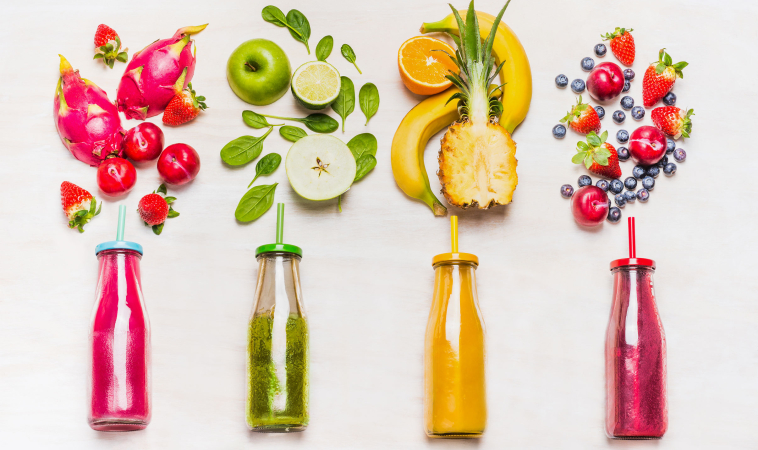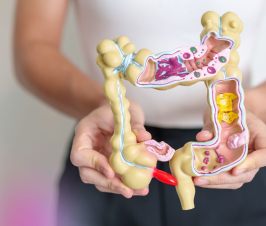It’s so interesting how old concepts so quickly become the new craze in pop culture, before vanishing away almost as quickly into the shadows of yesterday’s news. In my work as a student clinician and also since becoming a board certified Naturopathic Doctor, I’ve encountered numerous questions and claims about a current craze – the smoothie. Now, while I know this sweet and creamy delight has been offered by establishments like Orange Julius for decades, the current hold it has on modern culture is fascinating. Many articles and websites exploit the benefits of smoothies, stating how they’re a great way to get more fruits and vegetables into your diet (what do you mean you don’t put vegetables in your smoothies?!) and how they make wonderful meal substitutes, especially for breakfast. As the warmer months approach and more people reach for this refreshment, it seems timely to explore the various aspects of its health profile.
The Good:
There is no arguing that smoothies do provide many added nutrients to our diets. This becomes even more beneficial when making green, veggie-laden drinks. In working with patients, I’ve come to learn that Americans are notorious for not eating enough vegetables – arguably one of, if not the, most important food group. Smoothies can grind down those leafy greens and fibrous roots into an easily swallowed liquid form, whose flavor is fairly easily covered by the addition of some fruits, yogurt, juice, or milks.
It’s also become clear that a large percentage of Americans don’t eat breakfast, as I’ve discussed in other articles I’ve written. Breakfast is an essential opportunity to get some of the required daily nutrients into one’s diet, and unfortunately many people miss out on this due to time constraints. Smoothies are now seen as a quickly prepared food that can be easily taken out the door when you’re in a rush. Recognizing these as dilemmas that many people face, the smoothie is a great solution to this problem.
The Bad:
While it is super easy to pack your smoothie full of nutrient-dense vegetables, the reality is that most smoothie drinkers don’t do this, and end up with fructose-heavy imbibes. There are also many people who opt for buying a smoothie from a retail spot on their way into work or as a post work-out recovery drink. However, most commercial smoothie joints sell sugar-packed delights under the guise of health drinks. If you take a look at the ingredients, most prepared smoothie drinks are full of fruit purees, juices, and sorbets – all high in sugar. A study published in BMJ Open in March of this year by Boulton et al., investigated the amount of sugar in various children’s drinks, including fruit juices, juice drinks and smoothies. Out of 203 drinks surveyed, smoothies were found to contain the highest amount of sugars (greater than fruit juice or juice drinks). Drinks also contained various, and in some, multiple forms of sugar, including sucrose, non-caloric sweeteners, and glucose-fructose syrup. Out of all the products in the study, 85 (over 40%) contained the entire maximum daily amount of sugar for a child.1 This is a shocking recognition about a drink that has been overly popularized as healthy. While this study was focused on drinks consumed by kids, it’s reasonable to assume the findings translate to those for adults as well.
Further more, the sheer quantity of food consumed by means of a smoothie can be somewhat startling. If you were to lay out every ingredient that you pulverized in your blender, it would likely be an astonishing amount of food. And if you were to eat each ingredient in it’s non-liquefied form, there’s a good chance you would feel full or at least somewhat satiated before you even finished consuming it all, or you might find that you would have to spread out the contents over a more extended period of time. Imagine trying to fit all those whole fruits (and hopefully vegetables) and nuts and liquids and protein powders into your stomach, one on top of the other. Can we say indigestion! So in mixing and grating and mashing everything up together, we’re getting the same number of calories in a more condensed form. While this might not be such a bad thing for someone trying to put on extra weight, a large number of smoothie-drinkers don’t fall into this category. Depending on what is being added to the smoothie, these calories could be pushing people close to or over the top of their daily caloric requirements, as was suggested in the study I cited above.
The Ugly:
Despite our smoothies often being chalk full of calories, they don’t keep us from eating more. The average smoothie usually “holds over” its consumer for 1-2 hours. As I just highlighted, there’s an abundant amount of food in our smoothies, so how can this be? By utilizing our handy dandy blender friends, we eliminate a large percentage of the mechanical “break down” of food that’s usually carried out by our stomach and intestines. This kind of work takes time, and is responsible for keeping us full for longer. We’ve essentially bypassed the work, and therefore we’ve also removed the “holdover.”
Another problem I see is that an enjoyable smoothie is just that – smooth. You never really have to chew it. So not only are we removing the work that our guts are meant to do, but we’re also depriving our teeth of any action. Our teeth need to chew, grind, tear, and mash to stay strong and healthy. Just as a muscle gets stronger from heavy forces being applied to it, it’s a similar idea with our teeth. Also, smoothies essentially bathe teethe an acidic and high-sugar solution – both of which can lead to enamel erosion. This has the potential to become a prolonged problem, as tooth decay has been related to a number of health conditions including heart disease and diabetes. By liquefying our meals, we may be doing damage overtime to our chompers and overall health
The Verdict:
As a Naturopathic Doctor, I feel that balance is generally a good guiding principle. Smoothies can be a delightful treat and a delicious tool to include more fruits and vegetables into the diet. I myself enjoy a cherry or blueberry smoothie from time to time. But I also think moderation is key. Smoothies, if wisely crafted, can be healthy additions to one’s overall nutrient intake. However, they should not take the place of wholesome, well-balanced meals, and they should not be consumed daily for extended periods of time.
When making smoothies at home, it’s important to remember to limit high-sugar fruits like apples, bananas, mangoes and pineapples. Try including fruits that have a lower glycemic index rating and high antioxidant levels, like berries and dark cherries. Include nuts and seeds or nut butters to add protein and healthy fat levels and to also enhance satiety – it takes longer for your body to break down fat and protein molecules than it does for sugar so they can help keep you feeling full for longer. Adding half an avocado adds very little taste but offers some healthy fats and lends a frothy quality to your smoothie. Throwing in a beet adds a surprisingly sweet finish and excellent color.
For those who do use smoothies as a way to get additional fruits and veggies into the diet, I’d recommend trying some of these options instead:
- Reduce the number of smoothies you consume to half the amount if you’re currently drinking more than 3 per week
- It’s hard to get the recommended 5-7 servings of vegetables every day. Try including 1-2 at breakfast in non-smoothie form. This might seem odd at first, but it’s actually fairly simple and very satisfying. Throw some spinach into your omelet. Massage some kale with a little oil and vinegar before topping it with some bacon and runny eggs. One of my favorite breakfast dishes is roasted root vegetables (which I usually make the night before and then warm up the next morning) topped with a couple fried eggs and some smoked salmon.
- Try snacking between meals on fruits, vegetables, and nuts or seeds. These all add important nutrients to the diet – eating just 3 Brazil nuts covers your daily requirement for selenium – and the crunch they provide can satisfy “snacky” cravings. Consider nibbling on those items you would have normally included in your smoothie that morning.
- Substitute water or coconut water for milk products to enhance hydration and reduce calories.
With the heat of Summer arriving, many people will be turning to libations that cool their palates. While smoothies offer a satisfying and potentially healthier alternative to traditional soft drinks, it is important to remember that what goes in the smoothie, and how often it’s consumed, can make all the difference. Expand your homemade smoothie creations to include more vegetables, proteins, healthy fats, and less sugary additives, and feel good about indulging in this in-moderation delight.
 Dr. Kelsey is a Naturopathic Doctor and a Certified Kinesio Taping Practitioner™ who graduated from Bastyr University in Seattle, Washington in 2015. Dr. Kelsey grew up in Lakewood, Colorado and is now back home and seeing patients in the Denver area. When she isn’t at the office, Dr. Kelsey teaches in the Integrative Health Care program and MSU Denver, spends many days with her horse, Rumor, and enjoys running, AcroYoga, and country line dancing. Dr. Kelsey is an effective practitioner because of her open-mindedness, dedication, and attraction to helping others, along with a keen ability to simply “get” people.
Dr. Kelsey is a Naturopathic Doctor and a Certified Kinesio Taping Practitioner™ who graduated from Bastyr University in Seattle, Washington in 2015. Dr. Kelsey grew up in Lakewood, Colorado and is now back home and seeing patients in the Denver area. When she isn’t at the office, Dr. Kelsey teaches in the Integrative Health Care program and MSU Denver, spends many days with her horse, Rumor, and enjoys running, AcroYoga, and country line dancing. Dr. Kelsey is an effective practitioner because of her open-mindedness, dedication, and attraction to helping others, along with a keen ability to simply “get” people.
Dr. Kelsey is interested in helping her patients establish goals that will ultimately lead to enhanced wellness. She believes very strongly that diet, lifestyle, sleep, and stress greatly affect health and therefore always focuses on improving these areas as a foundation to her practice. Dr. Kelsey works with patients seeking general wellness guidance as well as those with more specific concerns. She enjoys assisting patients with stress management, sleep improvement, digestion optimization, immune wellness, cardiovascular and respiratory support, and has a strong interest in adolescent healthcare.
Dr. Kelsey also loves bringing a counseling aspect into her appointments as a way of connecting the body to the mind and spirit. To learn more about Dr. Kelsey and her practice, visit her website at www.determinanthealth.com.
References:
- Boulton J, Hashem KM, Jenner KH, Lloyd-Williams F, Bromley H, Capewell S. How much sugar is hidden in drinks marketed to children? A survey of fruit juices, juice drinks and smoothies. BMJ Open. 2016;6(3). doi:10.1136/bmjopen-2015-010330.

















